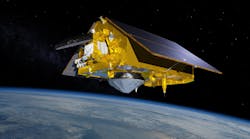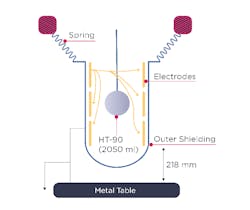NASA and other agencies that manage satellites over the course of their missions in orbit have difficulty tracking how much fuel is in its fuel tanks as the mission progresses. That’s because in orbit, fuel floats and sloshes around due to the low gravity in space, making it difficult to gage. To solve that problem, engineers at the National Institute of Standards and Technology (NIST) devised a fuel gage that relies on a low-cost 3D imaging technique known as electrical capacitance volume tomography (ECVT).
For decades, one of the most frequently used methods for tracking fuel in orbiting satellites required estimating how much fuel is burnt with each thrust, then subtracting that amount from the volume of fuel in the tank. This method is accurate when a tank is close to full, but error from each estimate carries get added to the next and increase with every thrust. By the time a tank is low, estimates are more like rough guesses and can be off by as much as 10%.
To lower the risk of collision with other operational satellites, NASA and other satellite operators horde the last of the fuel to be sure they enough to send the satellite up into a graveyard orbit, hundreds of miles from working spacecraft. Letting a satellite’s tank run dry would be a nightmare, as the satellite would be stranded it in its original orbit with no way to avoid smashing into other satellites, creating a dangerous debris clouds. But sending it into retirement prematurely with it still carrying excess fuel would be a waste of money.
“Every day a satellite stays in orbit probably amounts to millions of dollars of revenue,” says Dagalakis. “So operators want to use every drop of fuel, but not empty the tank.”
The new NIST gage uses ECVT to approximate an object’s shape by taking measurements at different angles. ECVT uses electrodes emitting electric fields to measure an object’s ability to store electric charge (i.e., its capacitance).
The first step in the project was building flexible electrodes. The team used soft lithography to print ink patterns on thin copper sheets with a flexible plastic backing. A corrosive chemical carved out the exposed copper, leaving behind the electrodes.
The team lined the inside of an oval container modeled after a NASA fuel tank with the flexible sensors. They were wired to received electric fields emitted by every other sensor and transmitted a field. But how much of each field ended up being transmitted depends on the capacitance of whatever is inside the container.
“If you have no fuel, you have the highest transmission, and if you have fuel, you’re going to have a lower reading, because the fuel absorbs the electromagnetic wave,” says Nick Dagalakis, a NIST mechanical engineer. “We measure the difference in transmission for every possible sensor pair, and by combining all these measurements, we know where there is and isn’t fuel and create a 3D image.”
To test out what the new fuel gage might be in space, the researchers suspended a fluid-filled balloon in the tank, mimicking a liquid blob in microgravity. Many liquids commonly used as fuel by satellites and spacecraft, such as liquid hydrogen and hydrazine, are highly flammable in the presence of oxygen, so the team opted to test something safer and more stable. It filled the balloon with a heat transfer fluid used to store or dissipate thermal energy in industrial processes. This fluid also closely mimics space fuel’s electrical properties.
The team took the capacitance data from the gage’s sensors to a computer, which created a series of 2D images that mapped the location of fluid in the tank. When these images were compiled, it built a 3D rendition of the balloon with a diameter that was less than 6% different from the balloon’s actual diameter.
The design could give satellite operators reliable measurements that would prevent satellites from colliding and keep them operational for longer.
If further developed, the ECVT gage could also help engineers and researchers overcome several other challenges presented by liquid’s behavior in space. For example, it could continuously monitor fluid flow in the many pipes on the International Space Station and help determine how the small forces of sloshing fluids might change the trajectory of spacecraft and satellites.

